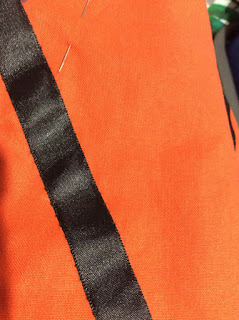Some months ago I challenged members of my local SCA group to create an embroidered piece with the theme of 'Something New'. It could be a new item of clothing, something in a new style, something using a new stitch or technique, etc.
My aim with this challenge was to make a budget friendly
partlet using items only from my stash. I also wanted to utilise some of the
stitches I planned to teach in my Introduction to Embroidery class at the 'Herman’s Hnefetafl' SCA event.
My embroidery pattern is adapted from Matthias Mignerak's "La pratique de l'aiguille industrieus" dated 1605. Lotz 140. (https://gallica.bnf.fr/ark:/12148/btv1b10526079n/f1.item)
I absolutely love the lace designs in this book; it is a wealth of pretty floral and fruit designs. I have another design underway as well, and plan to adapt many more for non-counted embroidery.
So far I have used split stitch and double running stitch, which can be seen on extant embroideries from places that my persona would be influenced by (sixteenth century Italy and England). The design is from a book dated slightly out of period, but I have seen similar designs in earlier pattern books. In a time before intellectual property laws and copyright, designs were unashamedly lifted and reproduced – often down to mistakes in the pattern being reproduced!
I chose a palette of purple for the design. The design is
adapted from a needle lace design. It is quite common for modelbuchs and
embroidery pattern books of the sixteenth century to be labelled or advertised
as for embroiderers, needleworkers, goldsmiths, artists etc, suggesting that
the publishers were aware that their
designs would be used in a variety of art forms.
The design and the colour palette remind me of a late 16th
century, purple embroidered Italian camicia held at the Met Museum. I am
tempted to add some gilt thread to my partlet, although it will make it itchy
to wear. That will be a decision for later on.
Analysis of this camicia can also be found in Patterns of
Fashion 4 by Janet Arnold.
The base fabric that I have used for the partlet is cotton,
because I am on a tight budget and I had it in my stash. Cotton was less
commonly used in the sixteenth century for middle and upper class undergarments
than linen, but of course is much more readily available and cheaper in modern
times.
Here is an extant embroidered petticoat worked on a
cotton-linen blend base which is held at the Museum of London:
Image from: https://collections.museumoflondon.org.uk/online/object/79216.html,
ID 59.77b
I have similarly used DMC cotton threads for the embroidery,
when silk would have been used in period. This choice is due to budget and
availability.
Another modern adaptation that I have used is marking the
design out in heat-removable Frixion marker. A range of options for marking out
were used in the sixteenth century, including ink(!) but I really like the
modern Frixion marker. I drew out my design in black texta on tracing paper and
stuck it to a sliding door to act as a sort of light box for marking out the
design.
I have a range of laces in my stash that I can use to edge
the partlet when the embroidery is completed. Plain and gilt bobbin lace as well as needle laces can be
seen edging camicia, partlets, coifs etc. in sixteenth century portraiture and
extant examples. Since I am not likely to have time to learn how to make bobbin
lace by the end of this challenge, commercially produced alternatives will have
to do.
I am also likely to add some sort of embroidered edging near
the centre front hem of the partlet, as this is commonly seen in sixteenth
century undergarment examples which have embroidery. I haven’t decided on a
design yet; I will wait until the embroidery is finished and choose something
appropriate then.





